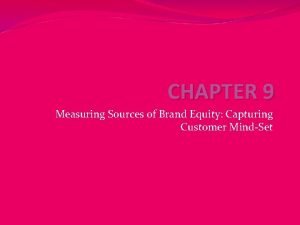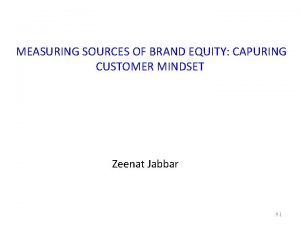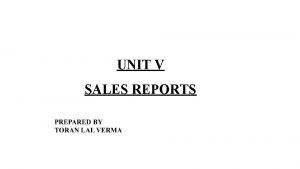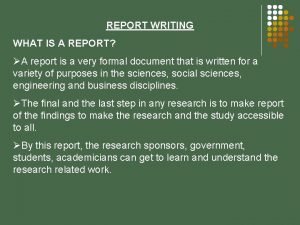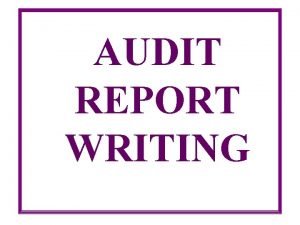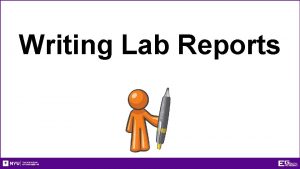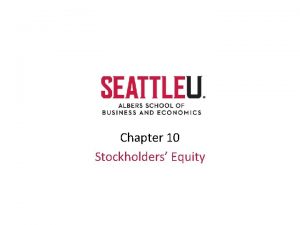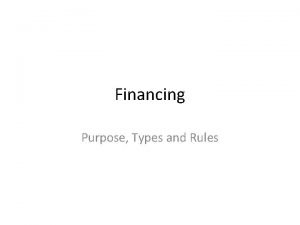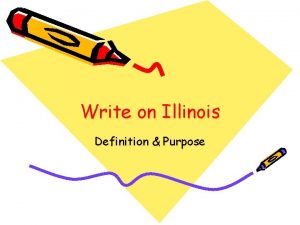How to Write an Equity Research Report PURPOSE














- Slides: 14

How to Write an Equity Research Report

PURPOSE OF A RESEARCH REPORT • What is the purpose of a research report? - Provide. . . - Relevant content - Unique insight and perspective . . . that will enable the reader to make an improved decision • What is it not? - Data dump - Value the reader’s time; use your space thoughtfully - More is not better. . . better is better. Data should be useful and easy to read - Inaccurate - You want conviction. . . but where possible let facts do the heavy lifting. - Don’t publish misleading information; seek economic truth! 2

KEY ELEMENTS OF A REPORT • Investment Summary • Business Description • Industry Overview • Competitive Positioning • Financial Analysis & Trends • Valuation - Methods and Model Assumptions • Investment Merits and Risks • Other Relevant Topics 3

INVESTMENT SUMMARY • In a handful of bullets, describe: - the company’s business model; - the key tenets of the investment thesis; - the key risks to shareholders; - its fair value; - and the expected return for buyers at the current market price 4

BUSINESS DESCRIPTION • Reader should get a brief intro - What do they do? - How do they make money (manufacturer, brand franchise, professional service, distributor, risk transfer, innovation, etc. ) - Changes in business mix/profile? - Who are their customers? - Business, consumer, government, etc. - How do they reach their customers? - Brick and mortar, direct sales, internet, catalog, etc. - Where do they operate? - Domestic, international (developed countries, emerging markets), etc. • Other - Major segments - Financial profile (growth rates, margins, leverage, cash flow) - Major recent developments worth mentioning 5

INDUSTRY OVERVIEW • Target addressable market(s) - Current and future growth rates - Industry life cycle • Market characteristics - Monopoly, Duopoly, Oligopoly - Global, regional, or local marketplace • Key industry demand drivers - End markets - Secular vs. cyclical trends • Industry trends - Globalization - Consolidation - Regulatory oversight 6

COMPETITIVE POSITIONING • What differentiates competitors? - Cost structure, scale, product/service quality, technology, intellectual capital (human, patents), customer relationship, geography, etc. • Porter’s Five Forces. . . he was onto something! - Rivalry – industry structure, S/D dynamics, fixed vs variable costs, exit barriers New entrants – barriers to entry (scale, capex, patents, product differentiation, etc) Substitutes – switching cost, relative price and quality Buyer power – concentration, product differentiation, integration threat, switching cost, co-dependence - Supplier power – similar to buyer power. . . • Market share - Market participants’ market share - Historical and projected gains/losses 7

FINANCIAL ANALYSIS & TRENDS • Historical and Projected IS / BS / CFS - Margins (gross, EBITDA, EBIT, net, etc. ) and growth rates - ROA / ROE / ROIC - Cash flow (OCF, FCF; per share and margin) - Sources (OCF, divestitures, share/debt issuance, etc) and Uses (Divvy, share/debt repo, acquisitions, capex) of cash - Working Capital (cash conversion cycle; % of sales) - Leverage (D/EBITDA, DTC, etc. ) - Capital requirements & Liquidity - Current/quick/cash ratio; covenants and debt maturity schedule - Appreciate the difference between liquidity and leverage! - Other industry specific metrics • Compare relevant metrics to competitors 8

FINANCIAL ANALYSIS & TRENDS - TIPS • Projected IS / BS / CFS should tie together • Make sure you don’t have runaway metrics - Projections should make economic sense • Don’t be mechanical; customize your analysis to the specific company and industry • Don’t take this section lightly! - Easy to mess up - Should be consistent with your qualitative assessment - Ultimately drives your valuation and recommendation 9

VALUATION • Valuation is an art, not a science. . . • Discounted cash flow - Growth and margin assumptions - Terminal value and discount rate • Multiples (P/E, P/FCFE, EV/FCFF, EV/EBITDA, EV/EBIT, EV/S) - User beware - When using multiples you implicitly accept historical multiples as an accurate assessment of value - Underlying a multiple is math. . . make sure it works and understand the logic - Peers (make sure similar attributes) Transactions (make sure similar attributes) Historical (make sure the company hasn’t changed) Market 10

MODEL ASSUMPTIONS & RISKS • Garbage-in, garbage-out • DCF model assumptions - Margin assumptions - Revenue drivers, bottom-up where possible - Cost drivers, bottom-up where possible - Discount rate - Long-term growth rate; forever is a long time. . . be conservative - WACC/FCFF or Ke/FCFE - Terminal value - Be careful - “Similar to the Hubble telescope. . . move an inch and you’re in a new galaxy” • Risks to estimates - Micro misses – fundamental economics of business change, industry landscape - changes, balance sheet impairs equity owners Macro misses – recession, interest rates, inflation, etc. 11

INVESTMENT MERITS • What attributes make this a good investment? * - Favorable fundamental attributes - Strong market position, pricing power, strong brand, favorable outlook - Attractive industry landscape - Barriers to entry, rational competitors, secular tailwinds - Balance sheet flexibility - Attractive valuation - Good capital allocators - Favorable ST/LT outlook * Assumes a buy recommendation 12

INVESTMENT CONCERNS • There are literally pages of risks listed in the 10 -k • Ask yourself. . . what could go wrong? - Company specific - Customer/supplier concentration, cost inflation, loss of key product, substitution, balance sheet deterioration, headline risks - Industry specific - Increasing competitive landscape, unfavorable regulatory changes - Macro environment - Recession, interest rates, inflation, currency 13

OTHER RELEVANT POTENTIAL HEADINGS • Management summary - Executive profiles, recent changes, proxy statement • Ownership summary - Top shareholders, institutional ownership, insider ownership • Recent business initiatives / developments - New business segment, marketing and/or product strategy - Acquisitions or divestitures - Not always good. . . headline risk, manufacturing problems, regulatory changes, etc. • Recent balance sheet changes - Changes in capital structure, changes in debt or equity 14
 How to write an equity research report
How to write an equity research report The purpose of writing a report
The purpose of writing a report Research report vs research proposal
Research report vs research proposal Capturing customer mindset
Capturing customer mindset Equity research books
Equity research books Capuring
Capuring Writing a status report
Writing a status report Sperling letter array experiment
Sperling letter array experiment Purpose of sales report
Purpose of sales report What is an report
What is an report Purpose of financial report
Purpose of financial report Purpose of an information report
Purpose of an information report What is the primary purpose of writing a lab report
What is the primary purpose of writing a lab report Lab report purpose
Lab report purpose Purpose of writing report
Purpose of writing report



